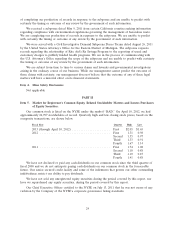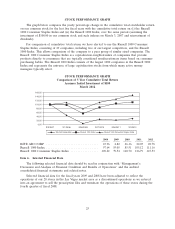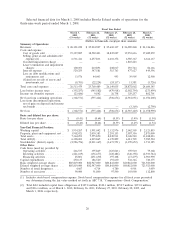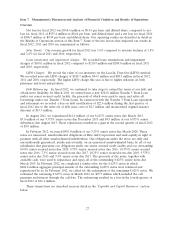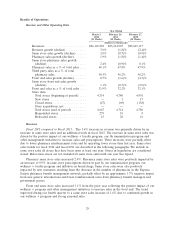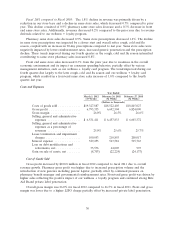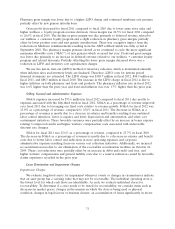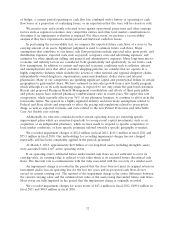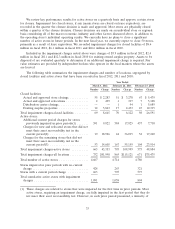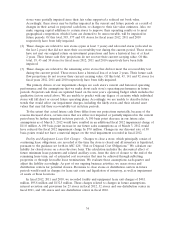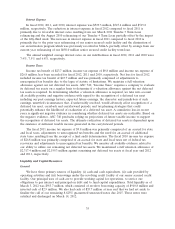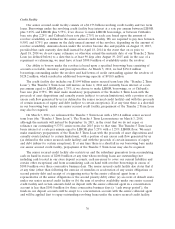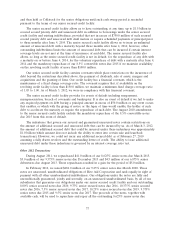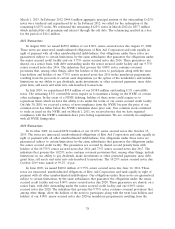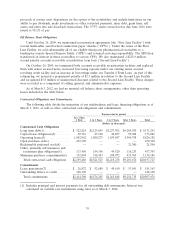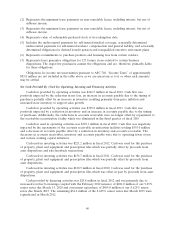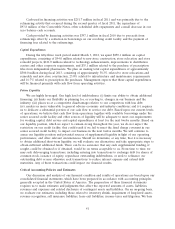Rite Aid 2012 Annual Report Download - page 34
Download and view the complete annual report
Please find page 34 of the 2012 Rite Aid annual report below. You can navigate through the pages in the report by either clicking on the pages listed below, or by using the keyword search tool below to find specific information within the annual report.stores were partially impaired since their fair value supported a reduced net book value.
Accordingly, these stores may be further impaired in the current and future periods as a result of
changes in their actual or projected cash flows, or changes to their fair value estimates. Also, we
make ongoing capital additions to certain stores to improve their operating results or to meet
geographical competition, which if later are deemed to be unrecoverable, will be impaired in
future periods. Of this total, 583, 577 and 431 stores for fiscal years 2012, 2011 and 2010
respectively have been fully impaired.
(2) These charges are related to new stores (open at least 3 years) and relocated stores (relocated in
the last 2 years) that did not meet their recoverability test during the current period. These stores
have not met our original return on investment projections and have a historical loss of at least
2 years. Their future cash flow projections do not recover their current carrying value. Of this
total, 19, 43 and 30 stores for fiscal years 2012, 2011 and 2010 respectively have been fully
impaired.
(3) These charges are related to the remaining active stores that did not meet the recoverability test
during the current period. These stores have a historical loss of at least 2 years. Their future cash
flow projections do not recover their current carrying value. Of this total, 43, 141 and 92 stores for
fiscal years 2012, 2011 and 2010 respectively have been fully impaired.
The primary drivers of our impairment charges are each store’s current and historical operating
performance and the assumptions that we make about each store’s operating performance in future
periods. Projected cash flows are updated based on the next year’s operating budget which includes the
qualitative factors noted above. We are unable to predict with any degree of certainty which individual
stores will fall short or exceed future operating plans. Accordingly, we are unable to describe future
trends that would affect our impairment charges, including the likely stores and their related asset
values that may fail their recoverability test in future periods.
To the extent that actual future cash flows differ from our projections materially, because of the
reasons discussed above, certain stores that are either not impaired or partially impaired in the current
period may be further impaired in future periods. A 100 basis point decrease in our future sales
assumptions as of March 3, 2012 would have resulted in an additional fiscal 2012 impairment charge of
$11.0 million. A 100 basis point increase in our future sales assumptions as of March 3, 2012 would
have reduced the fiscal 2012 impairment charge by $7.0 million. Changes in our discount rate of 50
basis points would not have a material impact on the total impairment recorded in fiscal 2012.
Facility and Equipment Lease Exit Charges: Charges to close a store, which principally consist of
continuing lease obligations, are recorded at the time the store is closed and all inventory is liquidated,
pursuant to the guidance set forth in ASC 420, ‘‘Exit or Disposal Cost Obligations.’’ We calculate our
liability for closed stores on a store-by-store basis. The calculation includes the discounted effect of
future minimum lease payments and related ancillary costs, from the date of closure to the end of the
remaining lease term, net of estimated cost recoveries that may be achieved through subletting
properties or through favorable lease terminations. We evaluate these assumptions each quarter and
adjust the liability accordingly. As part of our ongoing business activities, we assess stores and
distribution centers for potential closure. Decisions to close stores or distribution centers in future
periods would result in charges for lease exit costs and liquidation of inventory, as well as impairment
of assets at these locations.
In fiscal 2012, 2011 and 2010, we recorded facility and equipment lease exit charges of $48.1
million, $95.8 million and $132.5 million. These charges related to changes in future assumptions,
interest accretion and provisions for 23 stores in fiscal 2012, 52 stores and one distribution center in
fiscal 2011, and 108 stores and one distribution center in fiscal 2010.
34


